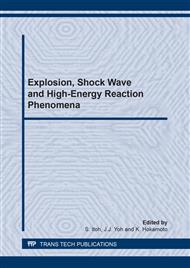p.101
p.107
p.113
p.119
p.125
p.131
p.137
p.143
p.149
Energy Dissipation in Explosive Welding of Dissimilar Metals
Abstract:
Explosive welding of two dissimilar metallic sheets is accomplished by the exhaustive deformation owing to high pressure and high temperature created at the collision place. This study addresses the analytical estimation of the dissipation of potential energy of the explosive initially to mechanical energy and then to thermal energy in dissimilar Copper – Low carbon steel combination. The emanating pressure in the region of detonation front is transmitted to flyer surface as compressive stress wave and a reflective tensile wave is generated at the bottom surface of the flyer. A dilational wave and shear wave are generated. As the flyer plate moving with the transmitted wave collides with the parent, the available kinetic energy is converted into thermal energy to produce adequate heat to induce plastic deformation thus resulting into a strong metallurgical bond.
Info:
Periodical:
Pages:
125-129
Citation:
Online since:
January 2011
Price:
Сopyright:
© 2011 Trans Tech Publications Ltd. All Rights Reserved
Share:
Citation:


